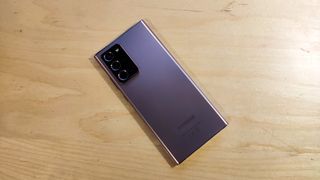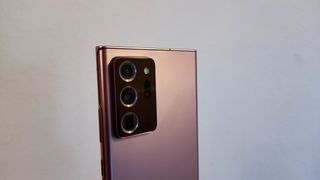IT Pro Verdict
Pros
- +
Gorgeous design
- +
120Hz display
- +
Fantastic camera
- +
Feature-rich
Cons
- -
Expensive
- -
Mixed performance results









It was a topsy-turvy 2020 for Samsung. The company saw its market superiority slipping in favour of Huawei, but this setback was offset by positive financial performance later in the year, with the launch of the mid-range ‘Fan Edition’ Galaxy S20 suggesting there’s a greater appetite than ever before for budget-friendly alternatives to high-performance devices.
Mid-tier devices are certainly enjoying something of a purple patch, but that hasn’t stopped Samsung from pushing on with the highest-end flagships, underlined by the upcoming Galaxy S21 series. Last year’s Galaxy Note 20 Ultra 5G, a luxurious 6.9in goliath, promises the best in every department while representing an improvement on 2019’s Galaxy Note 10+. Despite adding 5G support, a stronger processor, a silky-smooth display and a more powerful camera configuration, this latest flagship must prove it’s worth its exorbitant pricing at a time when value for money is becoming more important.
Samsung Galaxy Note 20 Ultra 5G review: Design
Galaxy devices tend to be exquisitely crafted, and the Galaxy Note 20 Ultra 5G is among the best-looking models Samsung has launched in recent years, oozing class from every pore. Its 6.9in screen spills beyond the confines of the display and blends into a ‘mystic bronze’ chassis, with its curved sides neatly contrasting the sharpened edges above and below the screen. The display, incidentally, is among the first to be reinforced with Corning Gorilla Glass Victus, a step above Gorilla Glass 6 in terms of toughness.

While the gold-rose-esque colour may divide opinion, we feel it’s the most appealing from a rather weak selection, which also includes a dulled charcoal or sterilised white. The handset otherwise features gorgeous accents that contribute to a stunning aesthetic, including a lighter, matte shade of bronze that coats the rear. This means the phone won’t easily slip when held, but it also emphasizes the glossy rectangular section which hosts the multi-lens camera configuration. The camera does, however, protrude so far from the rear that it’s best to source a protective case so the phone can rest more comfortably on surfaces.
Despite its sheer size, the Galaxy Note 20 Ultra 5G is marginally more compact than the S20 Ultra, as well as the 6.7in Oppo Find X2 Pro. With a thickness of 8.1mm, for example, it’s 0.7mm slimmer than the flagship Oppo device. Finally, both the power and volume buttons feature on the right-hand side of the chassis, while the ever-present S Pen is neatly tucked away under the display, beside speakers and a USB-C port.
Samsung Galaxy Note 20 Ultra 5G review: Display
Easily the best thing about the Note 20 Ultra 5G‘s gigantic 6.9in dynamic AMOLED 2X display is its 120Hz refresh rate. This puts the device into an exclusive category of smartphones offering a smoother scrolling and swiping experience, which helps set it apart given that its resolution of 1,440 x 3,088 and 496 ppi is pretty standard. Irritatingly, you can only use the maximum refresh rate if you drop the resolution to 1080p, but if you can live with the drop in sharpness, it offers a far more satisfying experience against devices that only support 60Hz - which is the maximum refresh rate that you’ll get at full resolution.
This, coupled with HDR10+ support, also means the Galaxy Note 20 Ultra 5G offers a brilliant experience on multiple facets, from browsing to streaming video. Features such as this, however, work well to mask a set of minor deficiencies we gleaned from more granular testing.

Its maximum brightness as well as colour accuracy scores are both subpar when stacked up against comparable devices. The Galaxy Note 20 Ultra 5G registered a disappointing 310cd/m2 maximum brightness and 93.7% sRGB colour gamut coverage when examined - surprising for a device with a long history of producing dazzlingly vibrant displays. Last year’s iPhone 11 Pro Max, by contrast, registered a maximum brightness of 758cd/m2 and 97.9% coverage of the sRGB colour gamut.
We can also compare this result with last year’s Galaxy Note 10+, which delivered a stunning maximum brightness of 715cd/m2 and colour accuracy result of 96.2%. The Galaxy Note 20 Ultra 5G’s results are, however, in keeping with Samsung’s alternative supersized flagship model, the Samsung Galaxy S20 Ultra, which registered 302cd/m2, although this was at least coupled with a very strong 98% colour accuracy score.
Options to configure the display to your liking are vast, though, and range from standard toggles such as dark mode and a blue light filter, to settings like accidental touch protection. You can also adjust the tone of the display between ‘natural’ and ‘vivid’ colour profiles, as well as tweak individual RGB values. There’s also an ‘easy mode’ for the visually impaired. Activating this enlarges font and icon size, strips back the home screen to the basics and incorporates a touch-and-hold delay to prevent accidental taps.
Samsung Galaxy Note 20 Ultra 5G review: Hardware and performance
Samsung’s custom-made Exynos chips tend to perform about as well as the most high-end Qualcomm Snapdragon CPUs fitted into alternative Android devices. The Galaxy Note 20 Ultra 5G features the Exynos 990 chip, however, which combines with 12GB RAM to offer somewhat subpar performance.

We should stress that variations at this level have a minimal impact on the day-to-day user experience, but the Galaxy Note 20 Ultra 5G doesn’t quite hit the heights of the excellent Snapdragon 865 chip fitted into many of the latest devices - and it’s even further away from Apple’s blisteringly fast A13 Bionic CPU from 2019’s iPhone 11. The 5nm A14 CPU, fitted into the iPhone 12 series, is expected to perform on another level entirely.
Geekbench 5 testing produced a single-threaded performance of 946, which is on-par with comparable Android handsets, although a multi-threaded result of 2,765 was only slightly better than last year’s much cheaper OnePlus 7T. The Oppo Find X2 Pro, meanwhile, blew the Note 20 Ultra 5G out of the water on multi-threaded performance, scoring 3,326. On the other hand, while you may desire more bang for your back, the Note 20 Ultra 5G doesn’t perform badly, and you probably won’t find this to be an issue in real-world use.
Similarly, battery lifespan is decent, if a little sub-optimal. The OnePlus 7T Pro, for instance, lasted 19hrs 39mins against the Note 20 Ultra 5G’s 18hrs 26mins. This is far from a bad result, and indeed much better than the Google Pixel 4 XL’s 15hrs 7mins, but there are stronger alternatives out there in this department, such as the Samsung Galaxy S20 Ultra, for instance, which lasts 22hrs 21mins. We can’t move on without mentioning the excellent fast-charge feature, though, which can recharge the Note 20 Ultra 5G in little over an hour.
Samsung Galaxy Note 20 Ultra 5G review: Camera
Photography is one of the Note 20 Ultra 5G’s true fortes thanks to a set of fantastic lenses and array of shooting options. The rear lenses are arranged in a strip formation alongside a laser autofocus sensor and flash module. It looks similar to the configuration fitted in the original Samsung Galaxy Note 20, but the quality of the lenses are beefed up. Included in this setup is a blockbuster 108MP primary wide-angle lens, 12MP ultrawide lens, and 12MP telephoto lens that accounts for a 5x optical zoom. This is in addition to a 10MP front-facing lens fitted into the notch-free display.
While this camera setup is incredibly similar to the Samsung Galaxy S20 Ultra 5G’s configuration, it falls short against its sister device in one or two minor ways, such as the latter offering 10x hybrid optical and 100x digital zoom. Nevertheless, it’s one of the strongest all-round configurations available in the high-end category, and combines with a wealth of software features and ‘professional’ fine-tuning to offer photography buffs a delightfully intuitive smartphone camera.

Users may adjust camera settings such as ISO, aperture size, shutter speed, focus and white balance in professional mode, for example, but beyond this there’s a wealth of AI-powered tools at your disposal. These include scene optimisation and shot suggestions. There’s also a reasonably effective night mode, and standard shooting modes such as panoramic shooting and a gimmicky augmented reality zone with an array of Snapchat-style filters. Various tools include an ‘emoji camera’ as well as ‘quick measure’. The latter tool serves a virtual ruler of sorts so you can measure the dimensions of an object or distance between them, or even a person’s height.
Shooting video is equally, if not more, sophisticated. The Note 20 Ultra 5G offers support for shooting in up to 8K resolution, which is a staggering (albeit largely needless) ability. Users can also take advantage of slow-motion and super slow-motion modes, steady-hand support, and high-precision professional shooting which lets you tinker with an array of settings to get your perfect shot. Overall there’s plenty to play with for those wanting a bit more control, but there’s also enough support for basic point-and-shoot photography.
Samsung Galaxy Note 20 Ultra 5G review: Software and features
Powered by Android 10, Samsung’s One UI 2.5 operating system sits at the heart of the manufacturer’s latest Note and Fold units. Beyond a range of camera and display features, the OS includes a handful of tools that complement an aesthetically pleasing user interface. Our only gripe is the default rounded-square shape of app tiles, though thankfully these can be fully customised along with the theme and background by accessing the theme store.
The broader design across Samsung’s prebuilt apps, such as Weather, is clean and fresh, but unfortunately the device comes packaged with a fair amount of bloatware. Thankfully, much of this can be uninstalled. Swiping left from the homescreen, meanwhile, pulls up Samsung Daily, a curated stream of content from media sources and apps that serves as a smart companion. As with comparable services, however, it’s largely useless.

On the more practical side, the Galaxy Note 20 Ultra 5G includes features such as reverse wireless charging, a ‘Link to Windows’ app, a Focus Mode which lets you deactivate any apps that might dare to distract you, and DeX, a service that turns your phone into a multi-functional peripheral for your TV or PC. This feature in particular has been one of our favourite aspects of the Galaxy series, as it’s fully-featured enough to serve a genuine desktop replacement for those with undemanding needs. Sadly, this is one area where the slightly disappointing performance may hold the Note 20 Ultra back.
Beyond that, the S Pen includes more comprehensive air gestures to make navigating your device much easier compared to previous generations, as well as triggers which can be assigned to a variety of functions. You can, for example, switch between apps, return to the home screen, and trigger ‘smart select’, a screenshot tool.
Samsung Galaxy Note 20 Ultra 5G review: Verdict
The Galaxy Note 20 Ultra 5G is among the best-designed smartphones Samsung has launched in recent years, and its 120Hz refresh rate renders the expansive display a pleasure to navigate, even taking into account the drop in resolution required to trigger it. This is despite the minor shortcomings that we identified in our testing.
It’s actually indicative of a wider trend with the Galaxy Note 20 Ultra 5G, in that the user experience is generally fantastic despite aspects such as the performance, battery life and display quality being bested by comparable alternatives. Nevertheless, its gorgeous aesthetic and premium build, combined with a powerful camera configuration, 5G support and the everpresent S Pen, means the Galaxy Note 20 Ultra 5G is one of the best options if you’re looking to purchase a device as monolithic as this.
The Samsung Galaxy Note 20 Ultra 5G is available from £75 per month with an upfront cost of £49 on the Vodafone network
Samsung Galaxy Note 20 Ultra 5G specifications
| Processor | Samsung Exynos 990 |
| RAM | 12GB |
| Screen size | 6.9in |
| Screen resolution | 3088 x 1440 |
| Pixel density | 496ppi |
| Screen type | Dynamic AMOLED 2X |
| Front camera | 10MP f/2.2 |
| Rear camera | 108MP f/1.8 wide, 12MP f/2.2 ultrawide, 12MP f/3.0 telephoto |
| Dust and water resistance | n/a |
| 3.5mm headphone jack | No |
| Wireless charging | Yes (reverse wireless charging) |
| Connection type | USB-C |
| Storage options | 512GB |
| Memory card slot | Yes |
| Bluetooth | 5.0 |
| NFC | Yes |
| Cellular data | 5G |
| Dual SIM | Yes |
| Dimensions (WDH) | 164.8 x 77.2 x 8.1mm |
| Weight | 208g |
| Operating system | Samsung One UI 2.5 |
| Battery size | 4,500mAh |

Keumars Afifi-Sabet is a writer and editor that specialises in public sector, cyber security, and cloud computing. He first joined ITPro as a staff writer in April 2018 and eventually became its Features Editor. Although a regular contributor to other tech sites in the past, these days you will find Keumars on LiveScience, where he runs its Technology section.